In my previous gardening post, I had introduced you to the selection of herbs which I had started to grow on my kitchen balcony. To date, I am happy to report that all have been flourishing and thankfully still looking green and healthy, except for my coriander and parsley.
Summer has been quite late to arrive in Zurich, making its appearance only now after what has felt like months and months of constant rain. I think the generous rainfall didn’t do any favours for my coriander and parsely, both of which started to become extremely tall and ragged from the excess water, before deciding to yellow and die in a tangled mess. I was not too disappointed in losing the coriander, especially since I didn’t think the taste was as pungent as those sold by my Asian grocer. But I was sad to see the parsley go, especially since it features regularly in my cooking. I think I will be content to resort to buying these two herbs; I’m quite happy not to have needy plants in my garden 🙂
But everything is otherwise looking good and I thought it was time to give everyone a glimpse of the fruit and vegetables which I am currently growing. Prior to embarking on this new gardening hobby, I would never have imagined that it would be possible to grow certain fruit and veges in containers and I queried about whether it would be worth the effort. But the time and money invested so far has proven to be well worthwhile, making me realise that maintaining a garden (albeit one on a balcony) can be a rather relaxing hobby with many happy returns.
Courgettes (Zucchini)
On a trip to the Loire Valley in France some years ago, we visited some awe-inspiring castles in the area which were magnificent not only for their well-preserved buildings and monuments, but also for their breathtaking gardens. Some had acres and acres of gorgeous floral arrangements, others were well-known for their clever garden mazes. But what I loved the most were the potagers, the vegetable gardens which were attached to most castles. Some potagers served to supply the restaurant on-site with the freshest, seasonal produce, whilst others competed with the floral gardens in the beauty and design stakes.
I surprised myself (and also my husband) by falling in love with each and every potager. I was often much more inspired by the gardens than the castle-tours which were meant to be the main attraction. And for some strange reason, I was always drawn to the courgettes, in part because it was the first time I had seen them in their natural state (i.e. not on a supermarket shelf), and in part because they are such beautiful and bountiful vegetables.
At the Château de Chinon, they had a lovely little vegetable garden which was home to some of the biggest courgettes and patty pans I had ever seen. The patty pans were about the size of my hand! I marvelled at how wonderful the courgettes looked and made a note in the back of mind to one day grow them in my own garden.
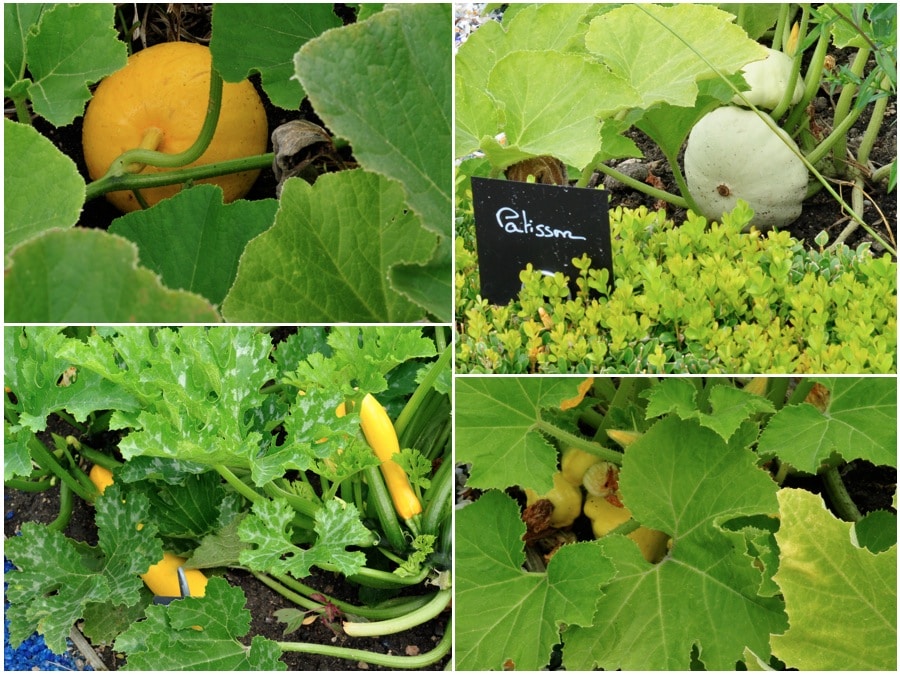
Well, given that a garden in the ground may never be an option for me, I was surprised to read in The Edible Balcony that Alex Mitchell recommended growing courgettes in window boxes. So I thought I would give it a try and bought two young courgette plants, one with round yellow courgettes and the other with green. I went with round courgettes because they are not commonly found at the markets or supermarkets around here.
On 5 May 2012, I planted both courgette plants in the same window box, measuring 16 cm x 16 cm x 58 cm (6 in x 6 in x 23 in), with my two cherry tomato plants. Within less than a week, the courgette plants had doubled in size and I made the sensible decision to quickly replant them in their own window box (of the same dimension). That was when I realised that the roots of the courgettes had very quickly grown and were quite established in the pot, making their removal quite a difficult task.

The courgette plants grew in leaps and bounds over the coming weeks, and the first flowers appeared just a few weeks later. The plants produce two types of flowers – the male flowers are those with a long, skimmy stem, whilst the female flowers are those which are later attached to the vegetable. It’s important to let the bees do their work in pollinating the female flowers, so it helps if you have other plants or flowers nearby to attract the bees to your garden in the first place. Otherwise, you can apparently hand-pollinate the female flowers.
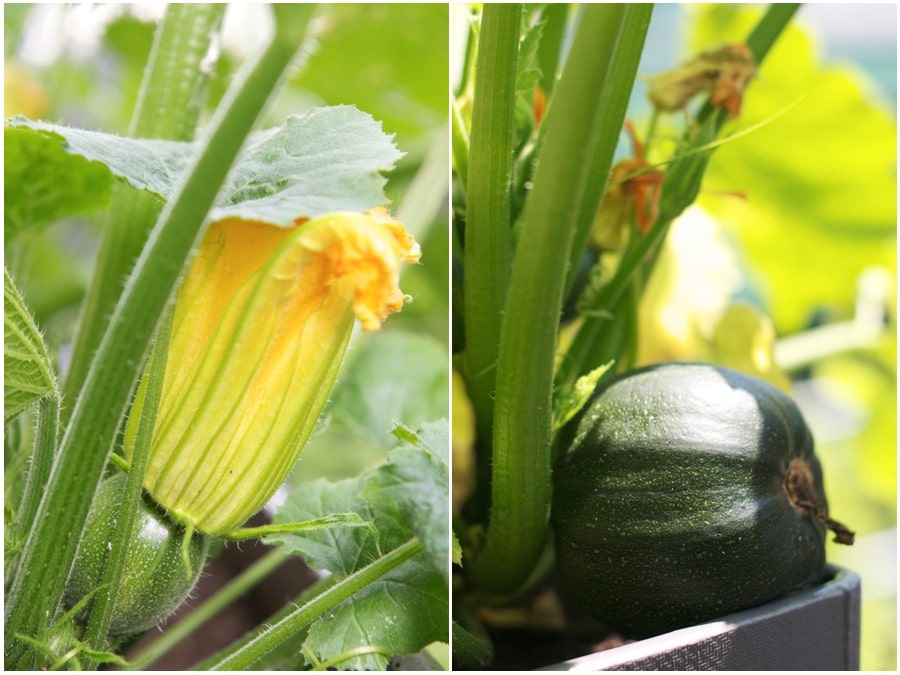
One plant can apparently produce up to 40 vegetables per season, and they grow rather quickly, so it helps to harvest the courgettes to encourage further growth. I wasn’t sure at first when to harvest the courgettes, but my gardening friends informed me that the courgettes are good to harvest once they reach a size just larger than a golf ball. It doesn’t take very long for the vegetables to reach the size of a small melon, though. These plants love the heat and you will find that they will grow much more quickly in warmer weather.
The one tricky thing about growing courgettes in window boxes is that the weight of the vegetables can be a strain on the plant. When grown in the ground, the vegetables sit on top of the soil. But in a window box, especially one that is suspended on the side of a balcony, the plants have nowhere to go but down, so be careful that the weight of the courgettes don’t cause your plant to break off. A strong stake to secure your plant would be worth the investment.

In terms of care, I found growing courgettes to be super simple. They require a lot of water, so I often watered them once a day in the evening, or twice a day if the forecast was for really warm weather. You should water them close to the roots, rather than directly over the middle of the plant itself, so that the water doesn’t collect and cause the plant to rot.
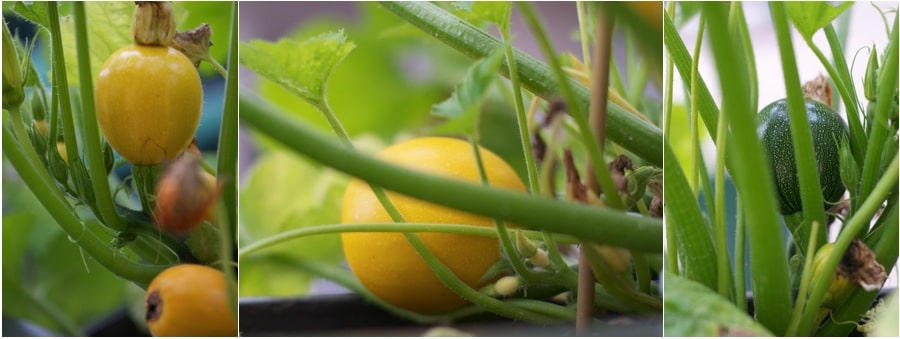
Following on from my previous gardening post about fertilising, I haven’t yet used any fertiliser on my courgettes. But as the leaves are looking a bit yellow and worn as of late (possibly due to a mixture of recent strong winds and dwindling nutrients in the soil), I might apply an organic fertiliser to see if this will encourage some healthier growth. That said, it looks like the old leaves are dying off and a new cluster of leaves are forming on each plant.
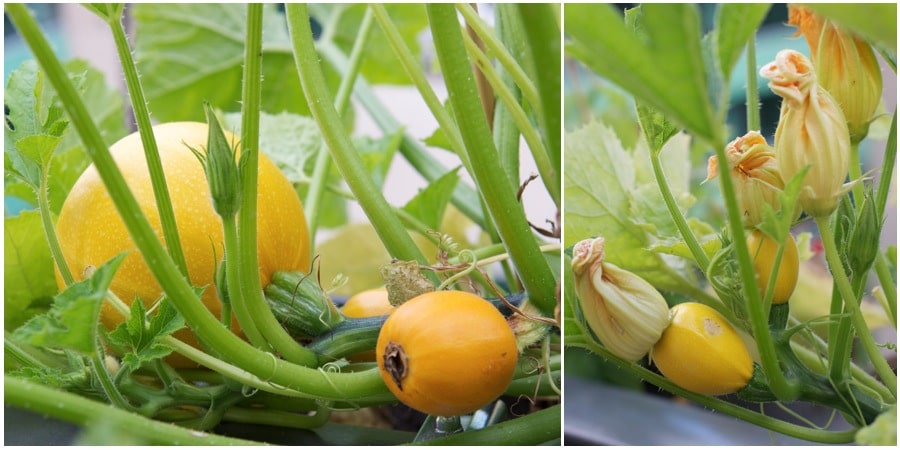
I think two courgette plants are enough for a small family, though keep in mind that the vegetables don’t grow at the same rate. So far, I have been harvesting about 1-2 courgettes every few weeks from each plant, which is the perfect rate of growth for our home. Though, strangely, the yellow plant seems to be producing more vegetables than the green.
They are great cooked in stir-fries, sliced thickly and grilled on the barbeque, or sliced thinly and served raw in a salad. At one point, I had enough to make Nigella Lawson’s Courgette Fritters which were lovely for lunch.
Although I had stuffed courgettes in mind when buying the round variety, I have only ever had at least 2 courgettes of the same size at the same time, which is naturally not enough for a dish. But going forward, I think I would still continue to grow this round variety on my balcony, primarily because they are a bit more unusual and not commonly found in the shops. I love how plentiful the plant is, how easy it is to maintain, and also how beautiful they look in the pot. It also helps that I haven’t had to buy courgettes this whole season, meaning that my two courgette plants have served their purpose very well this year.
Cherry Tomatoes
It was my neighbour who suggested that I try to plant cherry tomatoes on my balcony, assuring me that they would be low maintenance plants which would provide me with an abundance of tomatoes throughout the summer. And she was not wrong.
On the same day that I planted my courgettes, I also planted two small cherry tomato plants, one red and one yellow. After initially sharing the same window box as the courgettes, they soon found much happiness in their own pot. The plants started out as little 20 cm twigs when I bought them and, within a month, had grown into little trees. After 2 months, they loomed to over 1 metre in height! I worried that they were too big for the window box, but the abundance of flowers coming through in late spring assurred me that perhaps conditions were perfect for them.
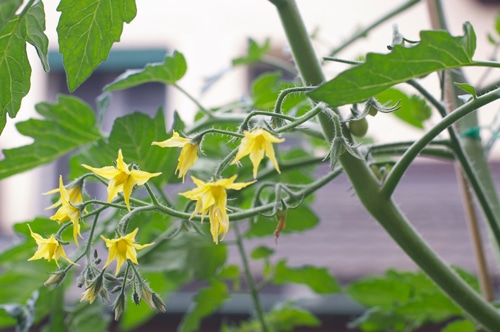
My balcony is an uncovered one which receives a lot of sunlight throughout the day. This is good for most plants as abundant light is necessary for growth. But too much light can also mean that the pots are prone to drying out, which means that you might have to water the plants in the morning and also in the evening if very warm temperatures are forecast.
My neighbours and I all have our balconies facing the same direction, yet mine is the only one which is exposed and, therefore, receives much more light. Although we didn’t carry out a strict science experiment using the same soil and seedlings from the same nursery, my neighbours also planted some cherry tomatoes on their balcony but theirs haven’t been thriving as much as mine. Whilst their plants are indeed growing tall with a few branches of fruit, the difference in lighting means that mine are flourishing much, much more. This could also be attributed to the quality of the soil and the plants themselves.

If I look at my neighbours’ cherry tomatoes, their plants have a single stem with just a few branches with fruit. Mine, on the other hand, have about 10 long branches each, each of them bearing three to four vines of fruit. The branches are so long that I have had to tie them back to a strong stake, giving the impression that I have more than 2 plants in my pot.

Growing cherry tomatoes on an exposed balcony means that any storms or strong winds can wreak havoc on your plants. I lost a few branches during a recent hail storm and had to upgrade from bamboo stakes (which can bend over time) to stronger ones made of steel. So far, so good.
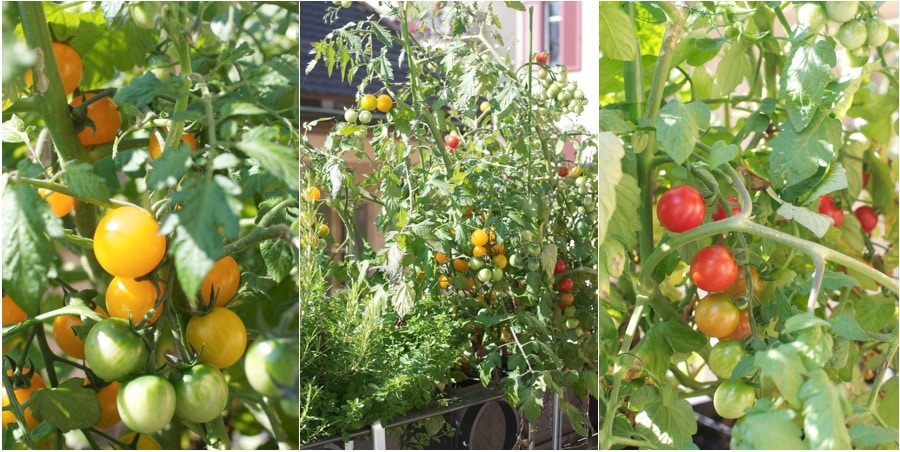
Although most gardening guides recommend a weekly application of fertiliser, following on from my previous hesitations, I opted not to fertilise my cherry tomatoes. Given the abundance of fruit which have appeared, I am rather thankful I didn’t.
A few people have also recommend pinching off branches as the plant starts to grow, thereby reducing the number of branches on the plant, which consequently reduces the number of fruit produced by the plant but intensifying their flavour as a trade-off. As this was my first year growing cherry tomatoes, I decided to let the plant grow freestyle and to re-assess next year. Although, the cherry tomatoes I have tasted so far have been mouthwateringly sweet and juicy that I have no complaints whatsoever about their flavour. Usually, I am not such a big fan of raw tomatoes, but these cherry tomatoes taste like nature’s candy that I think it would be a shame to cook them. I think they are best served raw in a simple tomato salad with just a vinaigrette.
With summer finally here, I can honestly say that growing cherry tomatoes has been rather low maintenance and I am quite excited by the harvest that lies ahead. I will definitely grow cherry tomatoes again next year, most likely in the same-sized window box. True, they do look a bit tall and funny in such a narrow container on the balcony rail, but I am rather grateful for the privacy they have provided against the neighbours directly opposite us. Who knew that cherry tomatoes could serve this purpose? Plus, they are so beautiful to look at – there is nothing more welcoming than to step out onto the balcony to see your plants laden with an abundance of fruit.
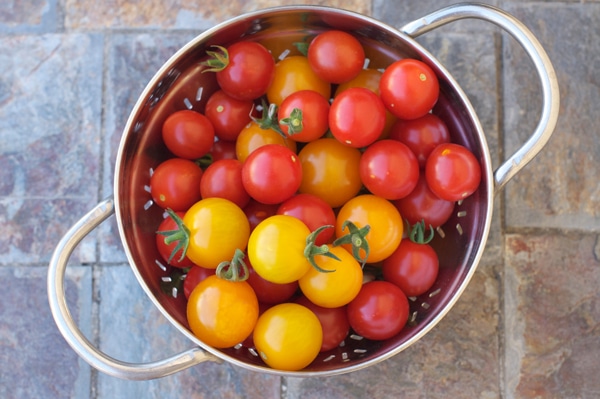
Thai Chillies
I wasn’t expecting to see Thai Chillies at the nursery, but then I shouldn’t have been surprised given that the nursery also had kaffir lime trees and Thai basil on offer. Given the amount of chillies I consume weekly, I knew these would be a welcome addition to my garden.
The plant has required very little care, other than the occasional watering to prevent the soil from drying out. I keep it next to my kaffir lime tree, both sitting under a sheltered part of the balcony and are, therefore, less exposed to the wind and rain. It is also the part of the balcony which receives the most sun during the day.
Despite being labelled “Thai chillies”, they look a bit smaller and fatter than the Thai chillies I buy from my Asian grocer. But thankfully, these little red bullets pack a punch, a welcome hit of spice given that the so-called Thai chillies I planted last year were so fruity that I thought they had been incorrectly labelled.
Along with my kaffir lime tree and Thai basil, I’m hoping that these chillies will survive the winter indoors. Has anyone had any experience growing chillies indoors?
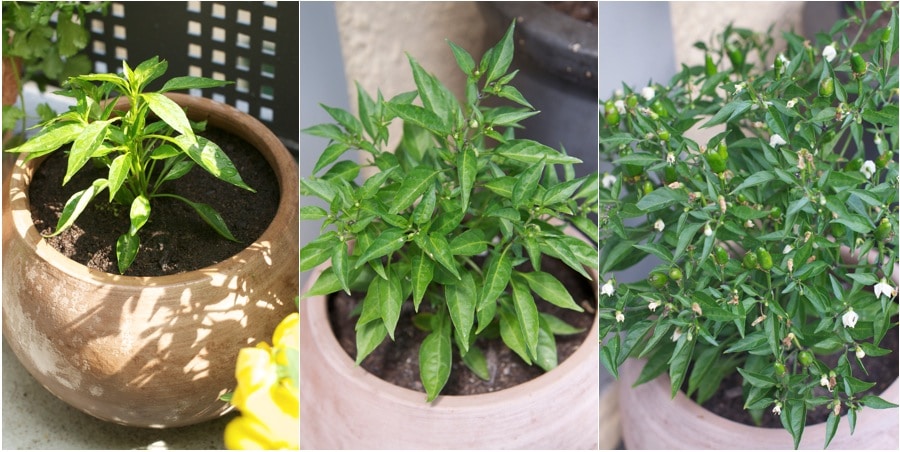
Strawberries
I wasn’t particularly sold on the idea of growing strawberries on the balcony, mostly out of selfishness; I knew that I could never grow enough to satisfy my own greed!
But as this was another plant which was recommended to me as being low maintenance, as well as one which can survive the European winter outdoors, I felt there would be no harm in trying.
I bought two plants each of Alexandria and Mara des Bois, the former producing tiny wild strawberries and the latter having large, juicy strawberries which are commonly found in the shops. Both varieties also have the advantage of bearing fruit throughout the summer, something worth keeping in mind as there are many varieties of strawberries which produce a lot of fruit in one go and then go on summer holidays until the following year.
The Alexandria strawberries were a novelty for me because I had tasted wild strawberries as a very young child and wanted to relive that taste experience again. The strawberries are minute and simply dissolve open entering your mouth. Unlike “traditional” strawberries, they have a white centre and are remarkably sweet. An online friend commented that they are great to grow in the ground because they can cover any unwanted weeds.
But my favourite are the Mara des Bois. Like the homegrown cherry tomatoes, these strawberries taste like how strawberries should taste – juicy, super sweet and full of summer in one bite. My biggest regret is growing only two of these plants – the two plants together produce about 2 or 3 strawberries at a time, which is just enough to tease and not enough to satisfy anyone’s appetite (especially if you have to share with your husband). Next summer, I am definitely planting more Mara des Bois 🙂
Bulgarian Peppers
During a recent a trip to Bulgaria, my neighbours brought back some pepper plants to plant on their balcony. And as the man who sold it to them was quite generous in giving them double what they had asked for, my neighbours kindly offered to me one plant from their collection. As I had sadly lost the battle with my coriander, I was grateful to plant something new in the same pot.
Within a week, the plant started to grow quite tall and produced many new leaves. Over the next month or so, it grew from about 20 cm high to about 80 cm, making me wonder if I should have actually planted it in a bigger pot.
The plant recently started to flower and I noticed just the other day that a green pepper had appeared. To date, I think it has been well-camouflaged by the foliage but I am quite excited to see how this fruit will develop over the coming weeks.
Has anyone else grown peppers or capsicums? I would love to hear your tips!
Kaffir Lime Tree
Following on from my previous gardening post where I first mentioned that I had planted a kaffir lime tree on my balcony, I am happy to report that this dear little plant has been absolutely thriving.
New leaves have been constantly forming, and the beginning of spring saw lots of tiny little blossoms which then formed into gorgeous little white-purplish buds, which have later developed into the kaffir limes themselves.
My little kaffir lime tree is now over-flowing with fruit, yet I’m still to research what I can do with these little green, brain-like balls, given that I have only ever used the leaves in cooking.
Unlike my other plants, my kaffir lime is the only plant to receive a weekly dose of fertiliser and it appears to be growing quite healthily due to the kick of nutrients. As the pot sits in a sheltered part of the balcony, I water it every few days when the soil looks a bit dry, and it also seems to love a good misting of water every now and then (I do this usually when it has been raining so that the plant doesn’t feel left out).
Overall, it’s a beautiful plant to have on the balcony and I feel so happy to have such a thriving kitchen garden!
Gardening Updates
Please visit my Facebook page for more photos and snippets of activity in both my kitchen and kitchen garden. Any gardening advice would be much appreciated!
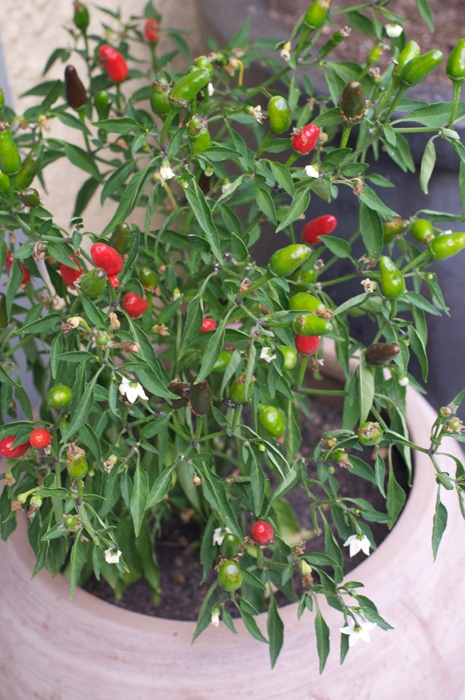
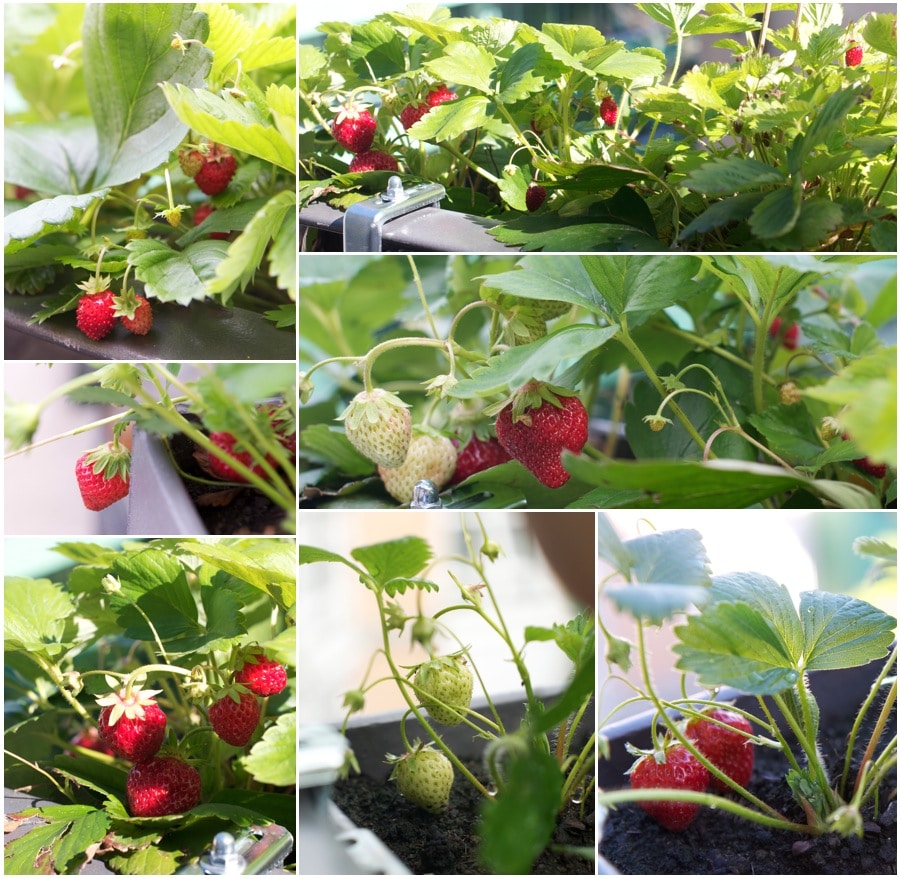
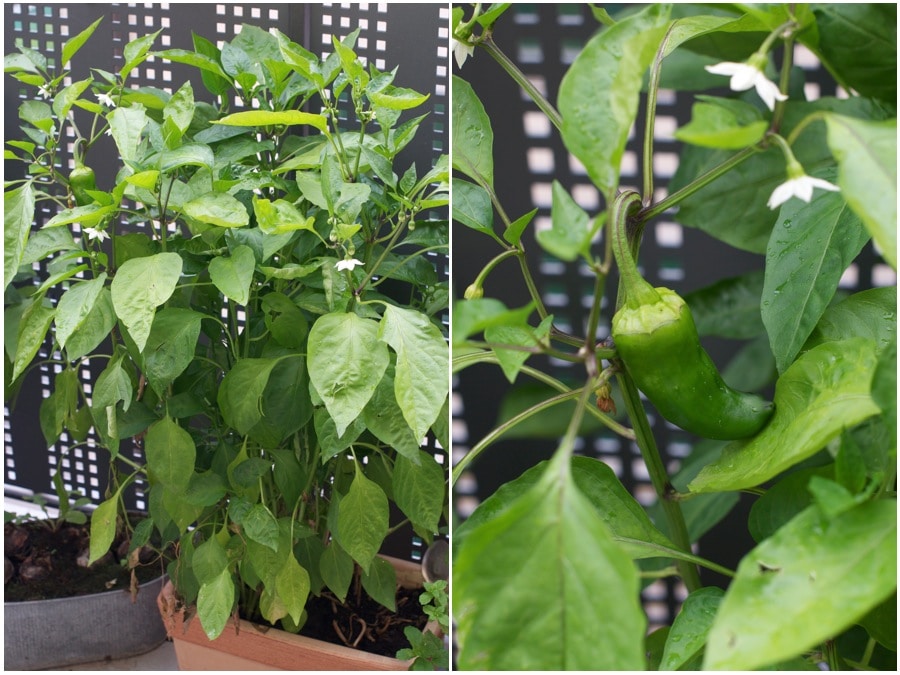

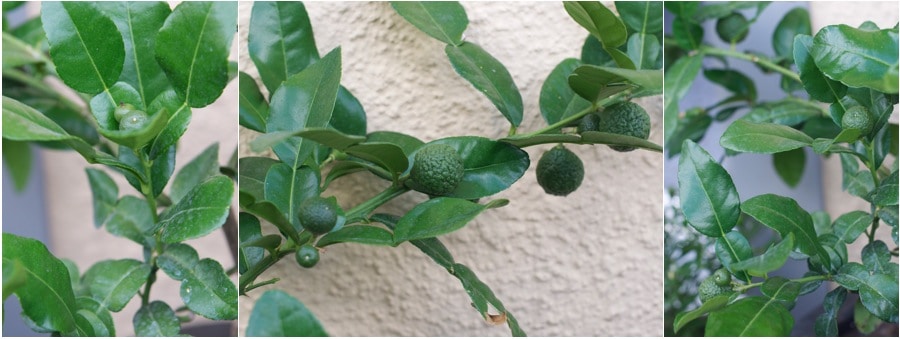

what a garden! You have nicer and better plants than my full earth garden! So lucky. You did realy well! Love all the pictures and your post 🙂
Thank you, Ann! And thank you for your tips along the way with the courgettes 🙂 I’ve had so much fun growing them this year. Can’t wait to see photos of your garden!
Thanh, you’re an amazing gardener! I love the strawberries! What’s your secret to keeping them healthy and producing fruits? All four of my strawberry plants died.
Ooh dear! I’m afraid I don’t have any secret tips … my gardening knowledge is quite limited and a lot of my efforts this year have been trial and error! Do your strawberries receive a lot of light? I think a good amount of sunlight is always key.
We had what I feared was too much rain this summer and I was worried that the strawberries would either die or the fruit would not taste very good. At one point, it had rained so much in consecutive days that the soil could no longer absorb anymore water and there was at least an inch of water sitting on top of the soil. Thankfully, it seems that my plants are doing fine, despite the torrential rain, and the strawberries themselves are sugar sweet.
I don’t apply any fertiliser to my strawberries, but you might find that a weekly dose of tomato feed or similar could do the trick.
Have you planted your strawberries in the ground or in a container? Perhaps planting them in the ground could raise different problems, such as unwanted pests and insects. I have mine planted in a container on a balcony so we are lucky not to have any unwanted bugs at this height.
Hopefully you will have better luck next time!
Oh wow. I’ve always wanted to grow my own fruit and veg but somehow don’t seem to have found the talent or patience yet! This post has massively inspired me though – I want my own courgette flowers!
I highly recommend growing your own courgettes! They are so easy to take care of and I love seeing new growth coming through and watching the courgettes get bigger and bigger everyday. Sometimes I feel like a child conducting a science experiment!
I haven’t been brave enough to pick the courgette flowers yet. I should pick the female flowers because once the vegetable starts to grow, I guess the flower has done its work. But I always leave the male flowers in case there’s still some pollinating work for them to do!
What an extensive, informative and inspiring post Thanh! You have totally sold the idea of ‘Your own kitchen garden in containers’ to me and so many others who are reading this post. Would love own a pepper plant !!
Thank you! 🙂 I was a bit skeptical about container gardening in the beginning, or should I say I was skeptical of my own gardening capabilities! But so far, so good. Only a few casualties but at least it wasn’t the more expensive plants! The tough part will be trying to keep some of them alive indoors over winter … But now that I have tried it, I will definitely keep up the gardening next spring 🙂
Gorgeous pics & great article!
This year here in London started out with a hosepipe ban, so i didnt plant as many things in the garden cause couldnt face dragging round buckets and watering cans after work every evening, and then of course it NEVER stopped raining! So some things i did plant almost drowned. Some of the herbs are doing well, salad is plentiful, but toms are unhappy and blackberry crop will be dismal. And basil rotted away – usually it is ok in the garden during summer.
I wont offer pics of my garden, i comfort myself with the thought that i go in for the “cottage” look, but overgrown semi-jungle is probably a better description 🙂
Oh dear, but at least some things seem to be doing well 🙂 I know where you are coming from with the watering cans – as I only have a balcony garden, I have to fill up our watering can about 5 or 6 times just to water the kitchen balcony. And then there is our other balcony which has flowers lined all long the railing … that is about another 4 refills of the watering can! I really ought to buy a bigger watering can but not sure I want to carry all of that weight. So the plentiful rain this spring/summer has been a relief on the watering front, but not so kind to some of my plants. My basil looks to be surviving although it is looking a bit yellow in places. I’m sure things might be different for me next year but I’m happy that my first trial of a kitchen garden has been mostly successful 🙂
I love this post, Thanh! My gardening attempts have been rather hit-and-miss – despite living in Brisbane, my courtyard receives limited sun. And when my parents come and stay with their dog… You have inspired me to rethink the order of things though!
You mentioned kaffir limes, and I thought immediately of a cookbook I bought this year, Cooking From the Market: Fruit. It says the kaffir (makrut) lime has very little juice, and the juice and flesh are quite bitter. Consequently, it lists no recipes using those bits of the fruit. They do look quite interesting though! (Maybe some seasonal installation artwork…?) Anna xo
Hi Anna! So lovely to see you here 🙂
I think a lot of gardening is trial and error, especially finding what works with the light that you have and perhaps soil conditions. My biggest challenge will be moving some of the plants indoors over winter and making them survive a good 6 to 7 months inside! Fingers crossed …
Thanks for the tip about the kaffir limes. I think I had also read somewhere that the limes had very little juice and perhaps they were most useful just for their zest. I rather like how they look on the plant so I might leave them for now. But the leaves are really beautiful and I absolutely love using them in my curries and soups. But what is a little annoying is that, now that I have my own kaffir lime plant, I don’t seem to be making curries as often as I used to! I’m hoping that will change once the weather cools down a bit soon.
Hope you are well! xxx
Beautiful post, thanks for the update! I bought a kaffir lime plant based on your recommendation last time and I looove it. It’s beautiful and so tasty! You are a much better gardener than me though because my tomato plant didn’t produce much at all (4-5 little tomatoes total!) and my Thai basil is not looking too good (the leaves are all tiny and very pale). I didn’t plant any strawberries this year but certainly will next year now that I saw how delicious looking yours are! And courgettes?! who knew courgettes could grow on balconies? wow I am impressed, they look gorgeous.
Caroline, lovely to hear your gardening update too! I’m so glad you are loving your kaffir lime tree because mine is also thriving. I just love how it looks with all of the little limes, though I need to give it a good prune soon for some Thai recipes I have in mind 🙂
Shame about your tomato plant … I think they love abundant light because that’s what I mostly give them! I initially thought two plants would hardly yield much for our home, but they have both produced so much fruit that I think two is definitely sufficient for us. Though, I would love to try and plant normal tomatoes as well next year.
My Thai basil is surprisingly doing really well. I thought it was a really fragile plant but it is definitely much more hardy than the coriander, and even the Italian basil. The leaves are now much smaller than when I bought the plant, but they are still coming through continously. In fact, the plant keeps on flowering – the moment I remove the flowers, more flowers spring up the next week!
And I highly recommend growing strawberries, especially since they are meant to survive outside over the winter, provided it is not too cold.